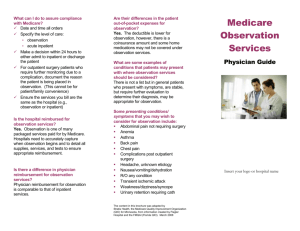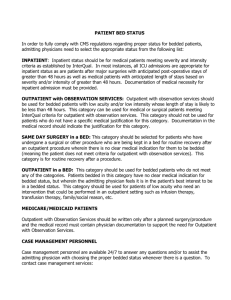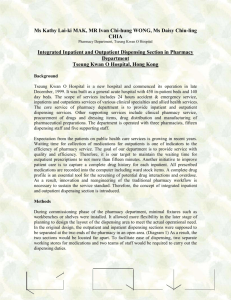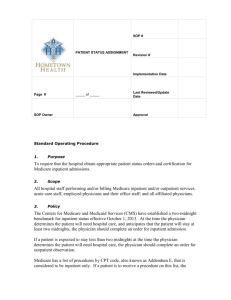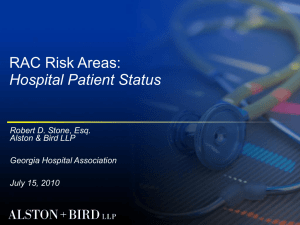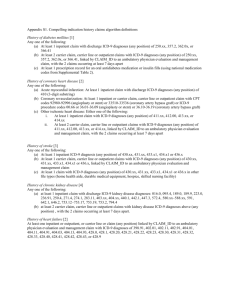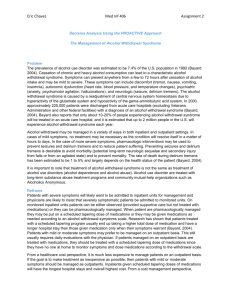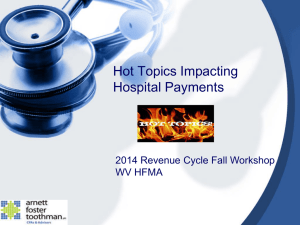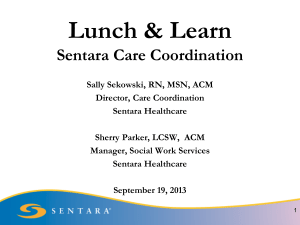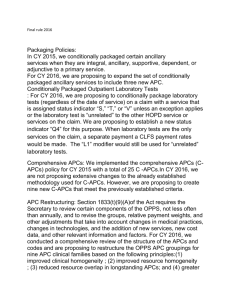St. Vincent*s Clinically Integrated Network: Implementation Plan
advertisement
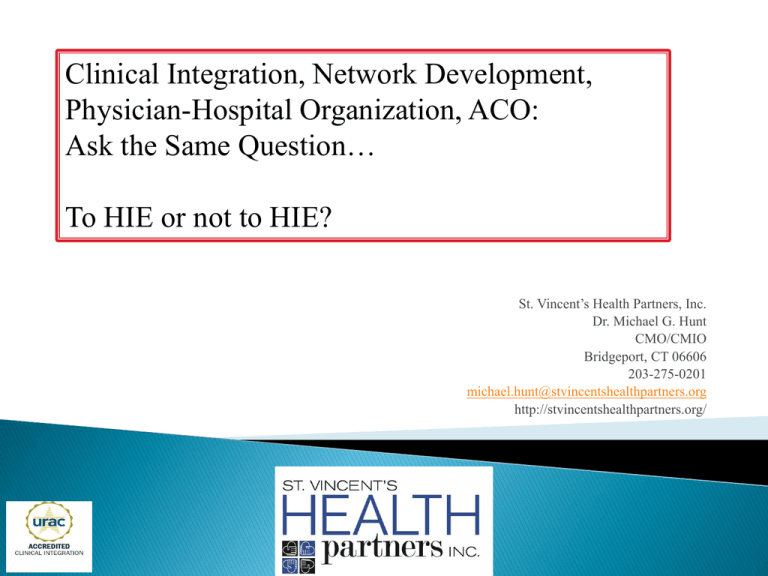
Clinical Integration, Network Development, Physician-Hospital Organization, ACO: Ask the Same Question… To HIE or not to HIE? St. Vincent’s Health Partners, Inc. Dr. Michael G. Hunt CMO/CMIO Bridgeport, CT 06606 203-275-0201 michael.hunt@stvincentshealthpartners.org http://stvincentshealthpartners.org/ A PHO is a legal entity generally formed by physicians and one or more hospitals with the intention of negotiating contracts with payers and sharing in the financial rewards of controlling costs while delivering high-quality care. 2 “Physicians working together systematically, with or without other organizations or professionals, to improve their collective ability to deliver high quality, safe, and valued care to their patients and communities”. Alice Gosfield, J.D. 3 An active and ongoing program to evaluate and modify practice patterns by the network’s physician participants and create a high degree of interdependence and cooperation among the physicians to control costs and ensure quality. This may include: Establishing mechanisms to monitor and control utilization of health care services that are designed to control costs and assure quality of care Selectively choosing network physicians who are likely to further these efficiency objectives The significant investment of capital, both monetary and human, in the necessary infrastructure and capability to realize the claimed efficiencies SOURCE: FTC/DOJ - Statements of Antitrust Enforcement Policy - 1996 4 Harold Miller: How to Create Accountable Care Organizations 2009 5 6 7 8 SVHP Hospital Member(s) Hospitals Skilled Nursing Facilities / Rehab / HHC Physician Members PCPs Specialists 1 Flagship Hospital – St. Vincent’s Medical Center 370 Providers (Physicians, PAs, APRNs) 52 offices > 40 specialties 9 Service Provision of medical care from a provider/facility directly to the patient Managing all elements of individual patient care Management Population Health Defining the operational roles of care coordination Enterprise level Defining the operational role of case management Facility level 10 Participate in Care Coordination services across the clinically integrated network while utilizing existing case management services in the hospital, ambulatory, ED, urgent care centers and SNF’s by identifying the additional Care Coordination needs and develop processes across the continuum for a seamless transition of care. SVHP Playbook Identified more than 140 care transitions and established baseline requirements for data portability Details quality metrics agnostic to Payer Reference for Care Guidelines – Preventative and disease management Organizational polices and plans 11 Goal: Meet Patient Needs and Preferences in Delivery of High-Quality, High-Value Care Bridging the gaps between: Primary Care Specialty Care Inpatient Mental Health Services Long-Term Care Medical History Test Results Home Care Informal Caregivers Patient/Family Education and Support Medications/Pharmacy, and Community Resources 12 13 14 15 16 17 Legacy Data from disparate Practice Management Systems Data Hospital(s) Laboratory Local and national companies Insurance Patient specific (EMR) Imaging Pharmacy 18 Optimize preventive and chronic disease management Primary and specialty care Reduce variations of care Care Coordination Focus the right treatment at the right time for the patient Identify and develop cost-effective management strategies Support initiatives Patient Centered Medical Homes Participation with ACO Maximize reimbursement P4P, PQRS, etc. Achieve clinical integration and physician adoption Share Data Between professionals and institutions With the patient Public transparency 19 Membership value to participate Priorities of membership Respect clinical workflow Just another tool not well utilized Cost and Budget Limited financial resources Quality and performance demonstration Use of available data 20 Data types Labs not based on LOINC Need for mapping between organizations Data receptivity Format HL7 CCD Flat file Patient transition and patient-specific information transfer Intramember patient communication Extrainstitution patient communication Competing priorities between stakeholders Technology System oriented versus independent members 21 If you do not measure it, you cannot improve it. IT is the backbone of the CI network's value proposition and is critical to improving coordination and connectivity between providers of care. Today the industry is inundated with tools to assist with monitoring and reporting the care provided to a patient. Two types of data sharing sources Health records patient registries repository that holds clinical information specific to a disease, disease process, implant, drug, etc Sources physician office Hospital ancillary care facility ambulatory care facility 22 Component Definition Method of Measurement Process Manner to ensure that care is given Clinical pathways Readmissions Rate of preventive testing Infrastructure Facilities, personnel and equipment used in the healing process Patient satisfaction survey Outcome Results of patient care Complications Cost of care Length of hospital stay mortality Morbidity Disease-specific function tools 23 Inpatient Readmission rates Medication reconciliation Care Coordination Outpatient Preventive Health Wellness exams Immunizations Mammograms/pap smears Chronic disease Diabetes CHF Asthma/COPD Acute and Chronic Care Management Measures Appropriate testing for children with pharyngitis Appropriate treatment for children with URI Appropriate antibiotic treatment for acute bronchitis New episode of depression: acute phase treatment New episode of depression: continued treatment AMI: persistence of beta-blocker treatment after a heart attack CAD: ACE inhibitor/ARB therapy Complete lipid profile for patients with CV conditions Heart failure (HF) : beta-blocker therapy PDC: for HTN (ACEI or ARB) PDC: for cholesterol (Statins) Diabetes: eye exam Diabetes: hemoglobin A1c testing Diabetes: lipid profile Diabetes: urine protein screening PDC: oral diabetes Annual monitoring on persistent medications: ACE/ARB Annual monitoring on persistent medications: anticonvulsants Annual monitoring on persistent medications: digoxin Annual monitoring on persistent medications: diuretics Arthritis: disease modifying therapy in rheumatoid arthritis Osteoporosis management in women who had a fracture Use of appropriate medications for asthma Preventive Care Measures Breast cancer screening Cervical cancer screening Childhood immunization status: MMR Childhood immunization status: VZV Chlamydia screening in women Glaucoma screening in older adults Adolescent well visits: 12-21 years Well-child visits in the first 15 months of life Well-child visits: 3-11 years 24 Inpatient Length of Stay Antibiotic usage Blood products/transfusions Readmission rate Outpatient Inappropriate ER use Inappropriate advanced radiology Costs pmpm for ED, Pharmacy, inpatient, outpatient, radiology Ambulatory Sensitive Conditions ER and Inpatient 25 McKesson Population Manager – Population Management McKesson Risk Manager – Risk Management/Value Based Contracting Clinical Informatics Systems – EHR/EMR/PMS/HIE/Pharmacy/Lab 26 Data Sources Clinical Lab Partners .CSV Results File Upload HL7 Interface Results Feed Quest Diagnostics Secure File Transfer Protocol (SFTP) Claims Feed Practice Management System Claims Data MSG - SVMC UCC – SVMC Goldfarb Ranno & Assoc. Allergy & Asthma Care, LLC Pulmonary & Internal Medicine Primary Care of Shelton Endocrine Associates, LLC Ehrlich Bariatrics Opthalmic Consultants of Connecticut Family Podiatry Center Dr. Reuvin Rudich Dr. R. Levin & Dr. L. Fliegelman McKesson Population Manager – SaaS/Cloud Physician Quality Reporting Point of Care Technology (Future) Physician Offices & PHO Hospital Partner Physician Hospital Organization (PHO) 27 Data Type Source Primary Practice Mgmt / Billing System(s) At each practice and not centralized. Clinical Events EMR systems. Providers Multiple sources. One provider could be in more than one source. TaxID & NPI’s are available for each provider (mid-levels too). Lab Hospital, Quest, Labcorp, CLP, POC labs Radiology Inpatient & Outpatient, may be different sources. POC radiology. Pharmacy Possibly Surescripts. Processed Claims Claims from insurers. Other 28 Data sources include: Demographic, ICD-9, CPT, CPT-2 from Practice Management Systems Prescription history from Surescripts HIEs Lab results from hospital, local labs, LabCorp, Quest EMRs Hospital State sources (Immunization Registry) Survey Data Payers Data entered on-line 29 Every night, registry processing runs automatically: PCP Assignment Registry Assignment Responsible Provider Medical Exclusions Registry Purge Compliance Calculation 30 Payer Medical & Rx Claims Membership Eligibility Providers Hierarchies DCGs ETGs EBM Connect Data Sentinel Rhapsody Data Mart Data Entered On line EMR, HIE Data Lab Results Patient & Population Risk Management: Predictive Models Risk Stratification Episodes of Care Management Quality Rules Benchmarks P4P Rules Formulary FDB HEDIS & STAR Management MPI Attribution Organization Hierarchy Pharmacy Mgt Workflow Engine MD Attribution & Correction Workflows Capitation Management PMPM & Utilization 31 Across the continuum of care: inpatient, outpatient and pharmacy 32 33 34 Attribution 39 American Hospital Association’s Center for Healthcare Governance Lakeshore Health Network Case Study, 2013 40
